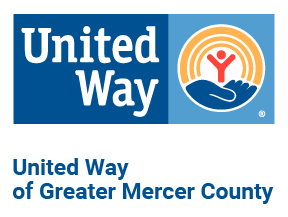V. RISK AND PROTECTIVE LIFESTYLE BEHAVIORS
This section examines lifestyle behaviors among Mercer County residents that support or hinder health, including individuals’ personal health behaviors and risk factors (including physical activity, nutrition, and alcohol and substance use) that result in the leading causes of morbidity and mortality among Mercer County residents. Also included in this analysis are some measures that are tracked as part of the Healthy People 2020 (HP2020) Initiative, a 10-year agenda focused on improving the Nation’s health. Due to data constraints, most health behavior measures are available only for Mercer County as a whole, not individual municipalities or subpopulations. Where appropriate and available, Mercer County statistics are compared to the state as a whole as well as HP2020 targets.
Healthy Eating, Physical Activity, and Overweight/Obesity
“We have a lot of resources here for activity and diet. Parks, good supermarkets, basketball courts. However, issues around obesity and related practices are not something that we have come together around to tackle as a community.” —Focus group participant
Similar to trends nationwide, issues around obesity—particularly healthy eating and physical activity—are important health concerns in the area that are associated with prevalent chronic conditions such as heart disease and diabetes. Yet, statistics indicate that Mercer County residents have similar behaviors to residents statewide. As seen in Figure 16, more than 70% of Mercer County and NJ residents reported eating fruits and vegetables fewer than five times per day (the recommended guideline), while approximately 25% indicated that they get no physical activity, according to the Behavioral Risk Factor Surveillance Survey. However, Mercer County and New Jersey rates for physical inactivity are still better than national figures. Healthy People’s 2020 target for physical inactivity is 32.6% because nationwide, 36.2% of U.S. adults report being physically inactive.
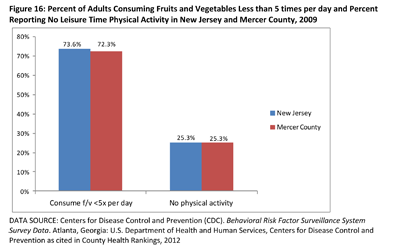
Community Resources for Healthy Eating and Physical Activity
Focus group members and interviewees overwhelmingly reported that there are many healthy community resources that encourage and facilitate these behaviors. When discussing physical activity, many focus group participants remarked that the county park system, basketball and tennis courts, and ball fields are easily accessible. Perspectives on whether this contributes to greater physical activity, though, differ. For example, some respondents held the perspective that “with all the resources and knowledge here, it seems like people exercise more in this community,” while others held the opposite view, noting “everyone drives – you can’t walk anywhere and people are too busy to exercise.” Some residents, however, reported fewer such facilities in their communities, particularly in the city of Trenton. As one focus group member shared, “there are no parks here. There’s Columbus Park, but there’s nothing there for kids. Not even benches to sit on.” While the review of parks and recreational sources were mixed, most respondents indicated that walkability is a county-wide problem.
Perspectives on the availability of healthy food options also differed across interviewees and focus group respondents. While some residents reported few or no fast food establishments in their communities, others, particularly more vulnerable populations, felt healthy food was largely unavailable to them. One community leader commented, “we have food swamps and food deserts.” Lack of transportation as well as cost were identified as barriers to healthier options for poorer and more vulnerable populations. Data confirm that more expensive healthier foods may be out of reach for some families as records show that enrollees in government-assisted food programs have increased in the last several years (Figure 17).
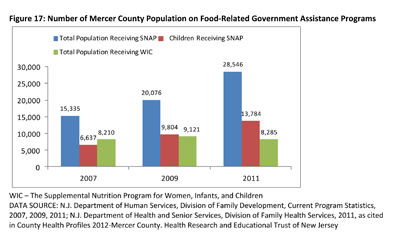
The Role of Schools
One area in which residents largely saw positive change was in the area of school nutrition. One adult focus group member remarked, “one thing I have seen change for the better is changing school meals. The choices have much improved.” Youth reported positive change as well citing increased availability of items such as whole wheat bread and water. As one teen focus group member shared, “you can’t buy lunch without a fruit or juice option.” Youth did point out, however, that candy is still offered in some vending machines and there are coffee shops in every school.
Teen focus group members also reported that, despite healthier school meals, there were challenges to eating better. They noted that academic pressures lead students to use the lunch hour to do homework or get homework support; as a result, they rush their meals or do not eat at all. Additionally, teens reported limited healthy and inexpensive food options outside of school. Eating out is a popular teen activity in Mercer County; however teens reported that they often opt for less expensive, but also less healthy foods. As one shared, “[name of restaurant] is keeping me from being healthy. The $2.50 cheese fries are not healthy, but I eat them all the time because I don’t have a lot of money.” A few youth focus group participants mentioned eating disorders as a concern among their peer group, which they attributed to stress and expectations.
Overweight and Obesity
Despite physical activity and nutritious options in many Mercer communities, a number of focus group participants and interviewees reported that obesity is emerging as a community issue, especially among younger children and new immigrants. As one service provider working with the Latino community explained, “part of it is what they [newer immigrants] think is assimilation. They come here, and they like Burger King because they want to be American.” Several residents noted that the emphasis on academics in schools has led to reductions in time for recess and physical activity. This, in combination with the prominence of organized team sports, has meant that those students not on teams have few opportunities to be moving. As one physician noted, “recess is only 8 ½ minutes long.”
Quantitative results show that the adult obesity rate in Mercer County in 2009 was slightly higher (25.0%) than that of New Jersey overall (24.7%), but substantially lower than the HP2020 target (30.6%) (Figure 18). (The U.S. target is higher because the national baseline of Americans currently obese is 34.0%). However, differences have been shown across various population groups, according to older data from 2004-2006 (the only data available by sub-group.) According to the NJ Center of Health Statistics report, the rate of adult obesity in 2004-2006 among non-Hispanic Blacks (36.5%) and Hispanics (24.4%) in Mercer County was higher than for the state as a whole (33.3% and 23.7%, respectively).
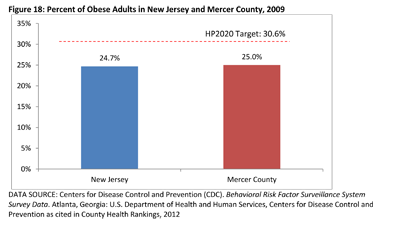
Childhood overweight and obesity rates for Mercer County were not available, yet rates for New Jersey in many indicators for adults have been found to be similar to Mercer County. According to the New Jersey High School Youth Risk Behavior Survey, 15.3% of New Jersey High School students are overweight with an additional 10.9% classified as obese (Figure 19). Further, a recent study found that compared to the national data, a higher percentage of Trenton public school children in all age categories were overweight or obese: nearly 1 in 2 Trenton children in every age category is overweight or obese, and more than 1 in 4 children in every age category is obese. Figure 19 also shows that as many as 72.0% of New Jersey high school students were eating fewer that the recommended amount of vegetables per day, while 13.3% were not attending physical education classes in an average week. Additionally, approximately one-third of students reported using computers for three or more hours per day, while another one-third reported watching television for the same amount of time.
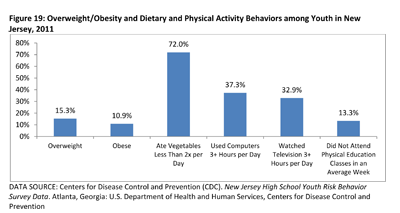
Substance Use and Abuse (Alcohol, Tobacco, and Other Drugs)
“Cigarettes are not popular among youth anymore. ‘Do you want to smoke’ now means pot.” —Focus group participant
“I worry a lot about the issue of drugs among youth. It seems to be growing, but it’s not an issue people want to talk about openly.” —Focus group participant
Substance use and abuse was identified as a pressing concern across nearly every focus group and interview. Residents believed that substance use was rising, especially use of alcohol and prescription drugs. One physician focus group member reported, “when I came here 16 years ago, it would be rare for us to see illnesses and diseases related to alcohol abuse, but now I see it every week. Substance abuse related hepatitis C is something I see a lot.” Residents attributed the use of substances in part to the declining economy but also blame community attitudes toward substances including widespread acceptance of under-age drinking and a general reluctance to acknowledge a problem. Specifically, there was a concern that parents and other adults were dismissive of alcohol and marijuana use among youth, while youth saw it as a social norm. Several parents and community leaders in focus groups commented that “alcohol is not seen as a big deal,” and that “there is widespread acceptance of under-age drinking by parents.”
Youth and Substance Use
Substance use among youth was noted as a particular concern. Respondents cited heavy use of marijuana, prescription drugs, and alcohol among area young people, but also reported increases in the use of opiates. Quantitative data reflect many of the themes discussed in focus groups and interviews (Figure 20). Alcohol and marijuana are the substances cited as most often used by area high school students, with 60.4% and 27.3% of Mercer County high school students reported using these respective substances in the past year. Approximately two in ten Mercer high school students report smoking cigarettes (18.9%) and one in ten said they have abused prescription drugs (9.4%) in the past year.
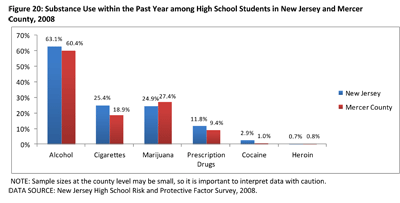
The reasons for high youth substance abuse in the region were several, according to focus group members and interviewees. While the availability of substances was identified as part of the cause, youth focus group participants more frequently reported that substance use was a consequence of stress, the lack of alternative activities, and the prevailing belief that everyone does it. Youth reported that the intense academics lead some students to use Adderall and other stimulants to stay awake and study. The lack of other activities for youth is another cause. A focus group respondent from a treatment center observed, “it’s one of those things where it’s [substance use] recreational. Because kids do not have other options. They spend their time doing these things.” Finally, respondents reported that among youth, there is the view that “it is not a big deal.” This is particularly the case with marijuana which is generally not perceived as an addictive drug.
Many focus group respondents and interviewees commented that their communities offer few options for youth and saw this as a concern. One focus group described her community as “a nine o’clock town.” Those working with youth reported that many organized youth activities are privatized and expensive and require transportation. This leaves young people with few options and according to several, could be a contributing factor to substance use. As one teen focus group respondent explained, “popular things to do around here are eat, smoke pot, avoid parents, and hang out.”
Crime Related to Substance Use
The following table reports rates of arrests due to substance use for the state and in Mercer County. Among youth and adults alike, arrests due to driving under the influence did not vary considerably. In terms of drug abuse violations, County rates were notably higher than statewide rates, particularly among adults (11.00 per 1,000 adults in Mercer County versus 6.68 per 1,000 adults across New Jersey) (Table 5). It is unclear at this point why these rates are so different, whether they are related to greater frequency of drug-related crimes in the County or more aggressive law enforcement in their likelihood to arrest.
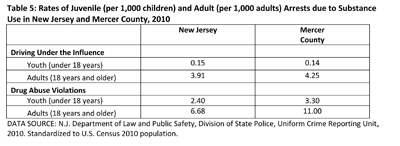
Substance Abuse Treatment
In 2010, there were 2,787 admissions in Mercer County to treatment facilities for alcohol and other drugs. Among these admissions, alcohol and heroin/other opiates were the leading causes of admission, with 34.8% and 31.1% of admissions respectively (Figure 21). Approximately 18% of admissions were due to marijuana. This distribution was similar to what was seen in past years, although slightly more admissions were due to cocaine in 2008 (15%) than in 2009 or 2010 (both approximately 11%). Among those 25 years and under, heroin and marijuana are the leading drugs for treatment. While treatment admissions are a promising sign of people seeking help, in 2009 the County experienced 41 deaths related to substance abuse.
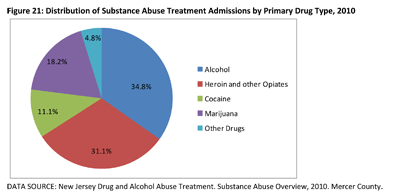
Focus group participants, particularly those who previously had a substance abuse problem or had a family member who did, discussed that the supply of treatment services did not seem to meet the demand. While there did not seem to be enough beds in treatment facilities, one of the most concerning issues was that treatment programs were not long enough or insurance did not cover them for a long enough period of time. Many indicated that programs lasted 30 days, but from their experience, a much longer time period for treatment was required to remain clean. As one focus group respondent remarked, “What I see is insurance companies approve treatment centers for 30 days, but that’s nowhere near long enough. I think there should be a 90-day minimum and insurance should not dictate how much time you spend in a recovery program. Medical providers should.”
Tobacco Use
Tobacco use did not emerge as a pressing issue in the focus group and interview discussions, with other substances such as alcohol, marijuana, and prescription drug abuse taking precedence. However, it should be noted that tobacco use is still a major risk factor for many of the preventable deaths in the U.S. While Mercer County’s youth and adult smoking rates are lower than what is seen statewide, the adult smoking rate is still higher than the national target for 2020 (Figure 22).
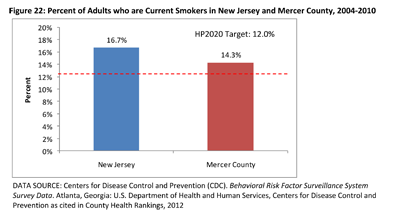
Risky Sexual Practices
“With all of the funding cuts in the state, we’ll see what happens related to pregnancies and high-risk behaviors among youth, young adults, and low income groups. Currently, services can’t meet current demand. I’m afraid it’s only going to get tougher.”—Interview participant
While not the most frequently cited issue, consequences related to risky sexual behaviors were discussed in several focus groups and interviews, particularly in light of cut-backs in government funding for related services. Several interviewees and focus group participants who worked with youth or in social service agencies discussed that the intersection of increases in substance use, higher stress due to the economic recession, and shortages in facilities offering family planning-related services may culminate in increased sexual risk taking and consequently greater rates of sexual transmitted infections (STIs) and unintended pregnancies.
Youth sexual behavior data for Mercer County were not available; however, according to the New Jersey High School Youth Risk Behavior Survey, 44.6% of New Jersey high school students reported having ever had sexual intercourse in their lifetime (Figure 23). Among those who have been sexually active, 37.4% reported that they had not used a condom, while 15.2% reported having not used any method to prevent pregnancy during their last sexual intercourse. Additionally, 22.2% of students responded that they had either consumed alcohol or used drugs prior to their last sexual intercourse.
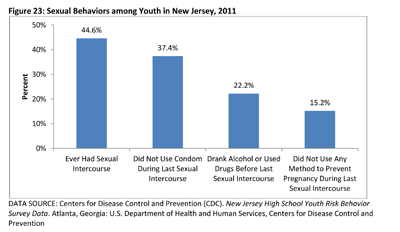
As with nearly all indicators, rates for reportable STIs vary greatly by municipality in Mercer County (Table 6). Rates for Gonorrhea and Chlamydia are more than three times greater in Trenton than they are countywide. Rates per 100,000 for Chlamydia are also much higher in Hopewell Borough, Hightstown, and Princeton Borough. All of these municipalities have a slightly greater percentage of the population that is under 25 years old compared to other communities.

The 2010 HIV/AIDS prevalence rate in Mercer County (408.8 per 100,000 population) was similar to the state rate (409.8 per 100,000 population. However, differences exist across different racial and ethnic groups. Among the 2,519 newly diagnosed HIV/AIDS cases in 2010, 68.5% of those individuals were Black, while 15.8% were White, and 14.7% were Hispanic.
